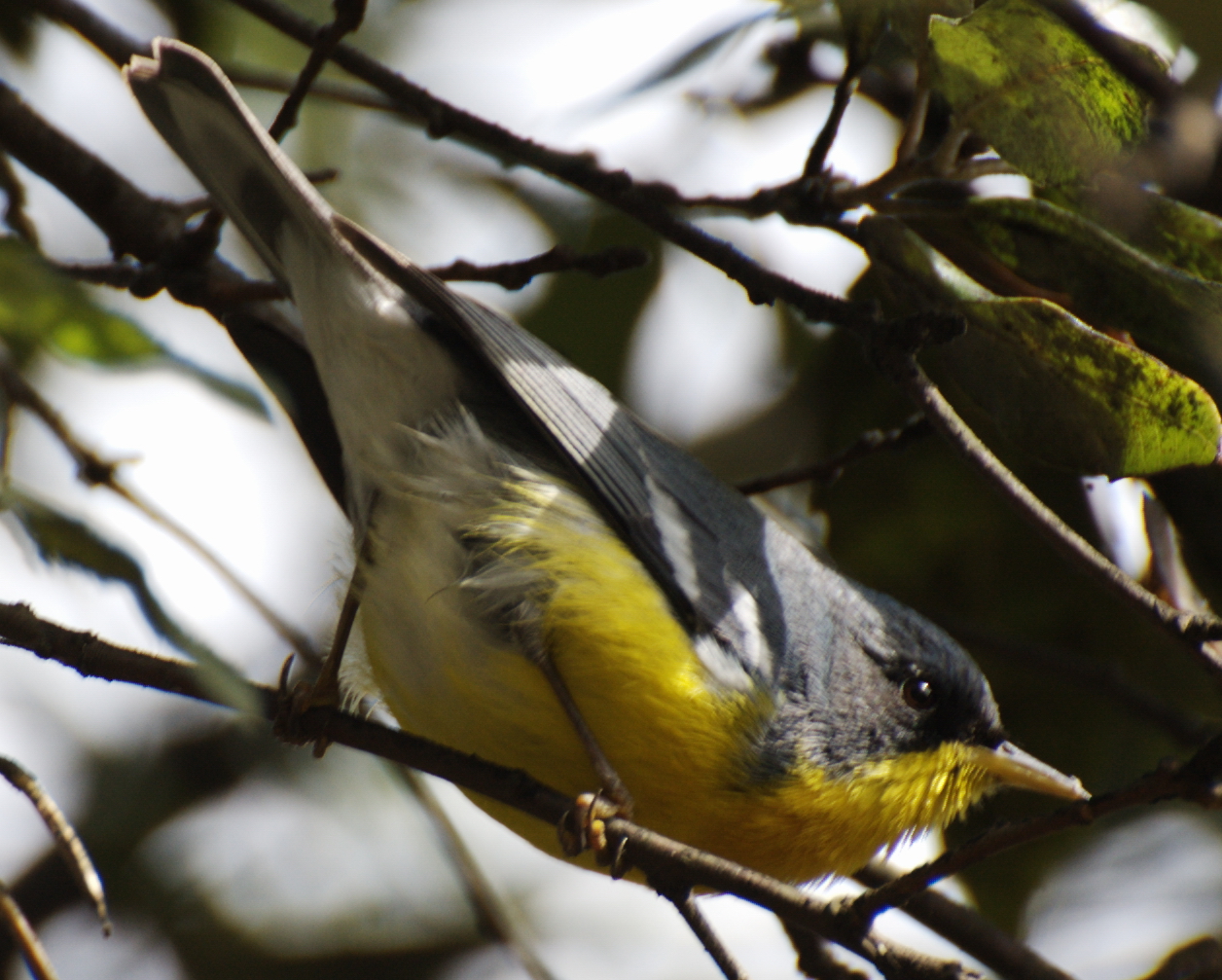- Tropical Parula
__NOTOC__Taxobox
name = Tropical Parula

image_width = 240px
image_caption = Adult (sex undetermined),Uruguay
status = LC
status_system = iucn3.1
regnum =Animalia
phylum =Chordata
classis =Aves
subclassis =Neornithes
infraclassis =Neognathae
superordo =Neoaves
ordo =Passeriformes
subordo =Passeri
infraordo =Passerida
superfamilia =Passeroidea
familia =Parulidae
genus = "Parula "
species = "P. pitiayumi"
binomial = "Parula pitiayumi"
binomial_authority = (Vieillot,1817 )
synonyms ="Parula americana pitiayumi"The Tropical Parula, "Parula pitiayumi", is a small
New World warbler . It breeds from southernmost Texas and northwest Mexico (Sonora) south throughCentral America to northernArgentina , includingTrinidad andTobago .This
passerine is not migratory, but northern birds may make local movements. For example, although it does not breed in much ofPacific Central America, it is a regular vagrant to countries likeEl Salvador [Herrera "et al." (2006)] .Description
It is 4.3 in (11 cm) long and has mainly blue-grey upperparts, with a greenish back patch and two white wingbars. The underparts are yellow, becoming orange on the breast. The male has a black patch from the bill to behind the eye.
Females are slightly duller than the males and lacks black on the head. The immature Tropical Parula is dull plumaged, lacks the wing bars, and has a grey band on the breast.
The song is a high buzzy trill, and the call is a sharp "tsit".
The Tropical Parula has about 14 subspecies, with a wide range of plumage tones. Some (especially insular ones) are considered separate species by various authorities.
"P. pitiayumi" has occasionally been lumped with the closely related
Northern Parula ("P. americana") as a single species. Hybrids are routinely found in theRio Grande Valley of southern Texas, though this may be a recent phenomenon. Most Tropical Parulas can be distinguished from the Northern Parula by their lack of white eye crescents, but this may be ambiguous in hybrids. One should also look for the distribution and extent of non-yellow coloration on the breast, and the extent of yellow on the malar and belly.In addition, a partially
leucistic Tropical Parula female was seen in 2005, atReserva Buenaventura inEl Oro Province ,Ecuador [Hosner & Lebbin (2006)] . With several small white areas on the forehead and around the eyes, this bird appeared much like a hybrid, but such birds would only occur as far south asPanama (if they would migrate like the Northern Parula).Ecology
The Tropical Parula is a species mainly of hill and
premontane forests, and does not occur in the Amazon basin. It seems to prefer moderately disturbed andsecondary forest and seems to cope well withhabitat fragmentation . On the eastern slope of theAndes for example it is regularly found at about 3,300-4,300 ft (1,000-1,300 m). There its habitat is a patchy mix containingprimary forest (e.g. high "Iriartea deltoidea "palm woods), wet premontane secondary forest dominated e.g. by "Elaeagia " (Rubiaceae ) and with abundantepiphyte s andhemiepiphytes such asClusiaceae , former clearings overgrown with shrubs, and fresh forest edges.Salaman "et al." (2002)]These birds feed on
insect s andspider s and occasionally berries. They may be seen to attendmixed-species feeding flock s, but often just coincidentially [Olson & Alvarenga (2006)] .The Tropical Parula nests in clumps of
epiphyte s, especiallySpanish moss , in a tree, laying usually two eggs in a scantily lined domed nest. Incubation is 12-14 days, mainly by the female.Footnotes
References
*|year=2004|id=53643|title=Parula pitiayumi|downloaded=12 May 2006 Database entry includes justification for why this species is of least concern
* (1994): "New World Warblers". Christopher Helm, London. ISBN 0-7136-3932-6
* (1991): "A guide to the birds of Trinidad and Tobago" (2nd edition). Comstock Publishing, Ithaca, N.Y.. ISBN 0-8014-9792-2
* (2006): Nuevos registros para la avifauna de El Salvador. ["New records for the avifauna of El Salvador"] . "Boletín de la Sociedad Antioqueña de Ornitología" 16(2): 1-19 [Spanish with English abstract] . [http://www.sao.org.co/publicaciones/boletinsao/01-Herrera.etal.RecordsSalvador.pdf PDF fulltext]
* (2003): "Birds of Venezuela". Christopher Helm, London. ISBN 0-7136-6418-5
* (2006): Observations of plumage pigment aberrations of birds in Ecuador, including Ramphastidae. "Boletín de la Sociedad Antioqueña de Ornitología" 16(1): 30-42 [English with Spanish abstract] . [http://www.sao.org.co/publicaciones/boletinsao/05Hosner&LebbinPlumage.pdf PDF fulltext]
* (2006): An extraordinary feeding assemblage of birds at a termite swarm in the Serra da Mantiqueira, São Paulo, Brazil. "Revista Brasileira de Ornitologia" 14(3): 297-299 [English with Portuguese abstract] . [http://www.ararajuba.org.br/sbo/ararajuba/artigos/Volume143/ara143not6.pdf PDF fulltext]
* (2002): New and noteworthy bird records from the east slope of the Andes of Colombia. "Caldasia" 24(1): 157-189. [http://www.unal.edu.co/icn/publicaciones/caldasia/24(1)/240111.pdf PDF fulltext]External links
* [http://www.birds-caatinga.com/species/parula_pitiayumi_voc_00.html Parula pitiayumi: Vocalizations] from "Avifauna of the Interior of Ceará, Brasil"
Wikimedia Foundation. 2010.
